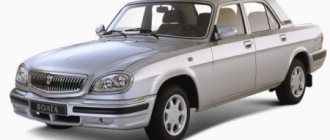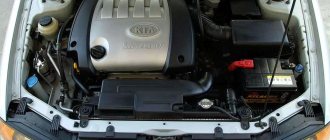Engine ZMZ-402
ZMZ 402 series engines are unpretentious in operation and quite easy to maintain. Gasoline engines with a carburetor have 4 cylinders arranged in a row. They were installed mainly on GAZ cars: Volga and Gazelle.
The design of the engine takes into account the ease of maintenance during operation. On the left side of the engine there is a gasoline pump 11, a starter 13, an ignition distributor 8, an oil pressure indicator and an oil pressure indicator sensor 29, an oil filter 30, a fine fuel filter 32, spark plugs 6, on the right side there is a generator 16, a gas pipeline with a sector 14 for regulating mixture heating, coolant drain valve with rod 17, body heater valve, water temperature sensor and carburetor 3. The coolant pump bearings are lubricated through a grease nipple on the right side of the engine. The sufficiency of the amount of injected lubricant is determined visually by the release of lubricant from the control hole on the pump body. Adjustment of the gap between the rocker arms and valves is carried out with the rocker arm cover removed; access to them is very convenient.
ZMZ-402 engine diagram
The working volume of the power unit is 2.445 liters, which allows it to develop a power of 100 hp. With. or 73.5 kW. The compression ratio is 8.2 - this allows the use of AI-92 gasoline. The cylinder diameter and piston stroke are 92 mm. The total weight of the unit is 181 kg. The exhaust system includes exhaust gas recirculation, which significantly reduces environmental pollution and allows you to comply with regulations.
Block head ZMZ-402
The cylinder block is integral with the upper part of the crankcase. It is die-cast from high-strength aluminum alloy. The cylinder block is divided into two parts by a horizontal partition, in which four holes are made for installing cylinder liners. The upper part forms a cooling jacket common to all cylinders. Along the contour of the shirt there are ten bosses for the cylinder head mounting studs. The lower (crankcase) part of the block is divided into four compartments by transverse partitions into which the main bearings of the crankshaft are installed.
Each cast iron bearing cap is secured to the block using two 12mm studs. Since the block is bored together with the covers, they cannot be swapped. Therefore, for convenience, they are assigned numbers stamped on all except the 1st and 5th.
A timing cover made of aluminum alloy is attached to the front of the block. And to the rear is the clutch housing. All connections are tightened with fastening bolts through paronite gaskets. The 402 engine has an aluminum head common to 4 cylinders. Fastening to the block is done with ten 12 mm studs. The cylinder head gasket is made of asbestos coated with graphite and surrounded by a reinforced frame. Its minimum thickness is 1.5 mm.
The crankshaft is five-bearing, with a large working surface of both connecting rod and main bearings. As a result, the specific loads on the bearings are relatively small. The main and connecting rod bearing shells are made of steel strip filled with aluminum alloy. Such liners are able to withstand heavy loads while maintaining high performance.
The camshaft rests on five bearings made of steel-babbite tape. The valve seats are made of high-hardness alloy cast iron to withstand high temperatures and shock loads. The valve guides are made of cermet with high wear-resistant properties. The valves are made of heat-resistant steel: the chamfer of the exhaust valve plate is filled with a more heat-resistant alloy. All critical surfaces subject to abrasion (cams and camshaft journals, pushrod tips, pushrods, rocker arms, rocker arm adjusting screws, etc.) are made of special material and subjected to heat treatment. Inserts made of acid-resistant, wear-resistant cast iron are installed in the upper part of the cylinder. All rubbing surfaces are lubricated under pressure. The lubrication system is equipped with a full-flow fine filter with a paper filter element.
Fuel consumption GAZ 3110 Volga 1997, sedan, 1st generation
| Engine capacity | Power | Transmission | Drive unit | Fuel | Consumption |
| 2.1 l | 95 hp | Manual transmission | rear wheel drive (FR) | Diesel fuel | 10,3 |
| 2.1 l | 110 hp | Manual transmission | rear wheel drive (FR) | Diesel fuel | 10,3 |
| 2.4 l | 100 hp | Manual transmission | rear wheel drive (FR) | Petrol | 13,0 |
| 2.3 l | 145 hp | Manual transmission | rear wheel drive (FR) | Gasoline AI-92 | 13,5 |
| 2.3 l | 130 hp | Manual transmission | rear wheel drive (FR) | Gasoline AI-92 | 13,5 |
Advantages of the old ZMZ-402 over modern engines
If someone happened to own a UAZ, Volga or Gazelle car from early years of production, he would definitely come across the ZMZ-402 engine or its Ulyanovsk analogues.
Once upon a time in our family there was a UAZ 469 produced in 1976, just the same with a ZMZ-402 engine for 76-80 gasoline, a working volume of 2445 cm3, a power of 76 l / s, with a compression ratio of 6.7 and torque of 160 Nm. Since then I have had the opportunity to drive different cars, including foreign cars. But the further I moved away from the 402, I realized how good it was.
To some, words of praise dedicated to the old engine, and some highlighted advantage over modern engines, may seem stupid, but it depends on how you look at it.
ZMZ-402 was produced from 1968 to 2021, periodically undergoing light modernization. As a result, 6,125,136 of them were produced.
The declared engine life is 250 thousand km before major repairs, but many owners of cars with a similar engine talk about 300 - 400 thousand km. In fact, this engine is eternal, as it has 5 repair sizes of the cylinder-piston group. By the way, the pistons with a diameter of 92 mm are exactly the same as on the V8 Gas-53.
In general, I would like to highlight the main advantages of the 402:
1. Relatively light. This reduces the overall weight of the vehicle and the load on the front axle. Thanks to the fact that the cylinder block and cylinder head are made of aluminum, its weight is only about 170 kg.
2. Very repairable. Due to the fact that the sleeves are removable, major repairs can be carried out right in the yard without any special skills. No special tool needed. Most operations can be performed with ordinary wrenches, with the possible exception of removing the crankshaft hub - you will need a puller.
3. Simple and clear design. Which cannot confuse you in any way. Knowing the general principles of operation of a four-stroke engine, you can easily find the cause of a particular malfunction yourself.
4. Good resource capacity. Especially when comparing modern engines, whose service life is comparable to the 402, they are usually thrown away and bought “contract”.
5. Your timing belt will never break, and therefore your valves will never bend. Because there is simply no belt. The camshaft is driven by a silent textolite gear directly from the crankshaft. The gas distribution mechanism itself is quite reliable. Periodically, only adjustment of the thermal gaps is required.
6. Grassroots motor. At the maximum possible 4400 rpm. the character of the engine is appropriate. The car starts easily at low speeds. Works great at medium speed.
7. Smooth operation in all modes. There is no “diesel” effect, as on the same Kalinas.
The disadvantages include: increased fuel consumption, not very stable idling, poor elasticity, low power and corresponding throttle response. Those cars that had this engine under the hood were quite heavy, so they all had an extremely low power-to-weight ratio. Overtaking and climbing are difficult.
Otherwise, this engine will take you home in any case. Even if on two cylinders, it will never die completely.
Source
Specifications 3110
Dimensions
Like all Volgas, the 3110 is not a small car. Almost 5 meters in length, the car has a fairly spacious trunk; the cabin can easily accommodate 5 people, including the driver. The ceiling in the cabin could be higher - tall people often rest their heads against it, especially the driver and front passenger.
Speed
The maximum speed of a car primarily depends on the engine installed and the type of gearbox. According to the performance characteristics, the “ten” with the 402 engine (on AI-92 gasoline) accelerates to 147 km/h, with the ZMZ 406 engine – up to 173 km/h. Considering that the 3110 of 1997-98 had a ZMZ 4021 internal combustion engine running on A-76 and 4st fuel. Gearbox, the speed with such data should be less than 147 km/h.
Clearance
Ground clearance according to the passport on the “ten” is 156 mm. For city limits and country roads, this clearance is enough, if not for one “but”. Due to the load on the Volga, the springs tend to sag, and over time, the rear of the car begins to drag along the road. The problem is solved in several ways:
- Additional spring leaves are installed;
- The springs are rolled;
- Either new standard or reinforced springs are installed.
Device diagram and design of springs for Volga 3110
Weight
The Volga is a heavy car, and it has always been that way, starting with the GAZ 21 model. The technical specifications indicate a weight of 1400 kg, but it seems that in reality it is somewhat heavier. According to reviews from car owners, an equipped car without passengers weighs about 1450-1500 kg. By the way, the technical characteristics of the GAZ 31029 indicate a weight of 1420 kg.
The technical specifications also indicate a carrying capacity of 3110 - 390 kg, but the data is given taking into account five passengers in the cabin. I wonder, if all five people weigh 100 kg each, the car won’t move? The volume of the trunk of the Volga is 3110,500 liters.
Specifications
The Volga 3110 with the ZMZ 402 engine had high technical characteristics. This power unit was transferred to the 3110 from no less famous cars - GAZ 24 and 2410. The engine with a lower camshaft had a long service life, which was 250,000 km, and with proper maintenance and care it could reach up to 300+ thousand km.
The Volga 3110 car ZMZ 402 engine has the following technical characteristics:
ManufacturerZMZModelZMZ 24, ZMZ 24DMModificationsZMZ 4021, ZMZ 4022, ZMZ 4025, ZMZ 24STEngine typeGasoline with the ability to install GBOTInjection typeCarburetorConfiguration4-cylinder in-line longitudinal internal combustion engineEngine power95 hp Number of cylinders4Number of valves8Pore diameter piston 92 mm Piston stroke 92 mm Cooling Liquid Block and head material Aluminum Resource 300,000 km Cylinder operating order 1-2-4- 3Ignition systemContact or non-contactFuel consumption GAZ 3110 Volga 1997, station wagon, 1st generation
| Engine capacity | Power | Transmission | Drive unit | Fuel | Consumption |
| 2.1 l | 95 hp | Manual transmission | rear wheel drive (FR) | Diesel fuel | 10,3 |
| 2.1 l | 110 hp | Manual transmission | rear wheel drive (FR) | Diesel fuel | 10,3 |
| 2.4 l | 100 hp | Manual transmission | rear wheel drive (FR) | Petrol | 13,0 |
| 2.3 l | 145 hp | Manual transmission | rear wheel drive (FR) | Gasoline AI-92 | 13,5 |
| 2.3 l | 130 hp | Manual transmission | rear wheel drive (FR) | Gasoline AI-92 | 13,5 |
Description of the motor
The cylinder block and head are made of high quality and durable aluminum right. But, if the motor is operated for a long time on water, the walls are destroyed by corrosion. A timing chain is installed inside the block.
The engine cooling scheme is quite simple: the pump pumps the “coolant” through a system that includes a thermostat, radiator, engine water jackets and pipes. The water pump is dismountable and consists of an impeller, housing, shaft, bearings and seals, which makes it possible to repair it.
The electrical circuit of the engine is quite simple, so almost every motorist will be able to understand it and identify faults.
Repairs and malfunctions
The ZMZ 402 engine is highly reliable, but due to many years of operation it is almost impossible to avoid breakdowns. So, the elements of the cooling system, electrical wiring and ignition most often break down.
If the engine cooling system malfunctions, coolant leaks will be visible or the engine will boil. Therefore, diagnostics of the power unit must be carried out constantly. Due to the age of the motor, the electrical circuit is often worn out and the wiring is broken. Therefore, when operating the power unit, you should pay special attention to this.
As for global problems, the following parameters will be signs of a major engine overhaul:
- Crankshaft knock.
- Worn piston group.
- High fuel and oil consumption.
- Low oil pressure.
- Leaks from the stuffing box.
- Other signs.
Refinement and tuning
Since the ZMZ 402 engine is not equipped with an electronic engine control unit, chip tuning is out of the question. The only thing that can be done is to replace the ignition system. An electrical diagram will help with this.
The engine can only be subjected to mechanical modification. So, the car enthusiast will have to bore the piston group, install new pistons that will be lighter than the factory ones, and also replace the camshaft and crankshaft.
Do not forget that when replacing the piston group, it will be necessary to change the connecting rods. The cylinder head can also be slightly modified. So, it is necessary to replace the valves and guide bushings. At the same time, it is worth replacing the valve seats.
After carrying out internal modifications, it is worth moving on to external tuning of the engine. So, the carburetor is changed. The best choice is the Czech Icarus, which was developed specifically for the GAZ 24 that participated in the races. Along with the carburetor, it is worth changing the air filter to a “zero” resistance one.
Also, the ignition system is replaced, namely spark plugs and high-voltage wires. The engine cooling system also needs modernization. The final touch is the installation of the engine cooling system kit.
Some modern car enthusiasts have tried to install a turbocharger or “snail” on the power unit. This modification did not always pay off. But changing the exhaust manifold and installing an upgraded exhaust system works great.











